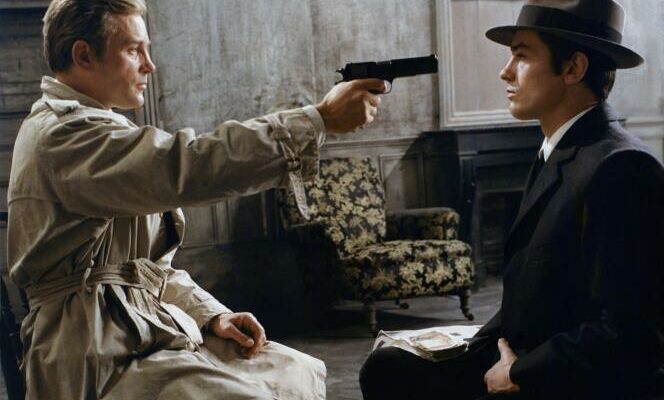By tackling the filming of Samurai, in June 1967, Jean-Pierre Melville had the idea of a black and white color film. A gray, cold, monochrome film, whose hero, an ascetic hitman, played by a brazen Alain Delon, brought with his precise and enigmatic gestures, the fetishism of his clothes, the sadness of his gaze, his apparent coldness.
” My dream, the French director then explained, it would be to make a film where only a small dominant would let us know that it is indeed a color film. I think we have taken a small step forward in a now dangerous form of expression: color cinema. We can hardly work in black and white anymore. »
Before The Samurai, Jean-Pierre Melville had only shot one film in color, The Elder of Ferchaux (1963) with Jean-Paul Belmondo. The director of Doulos (1962) remained a master of black and white. It would become that of color with the Samurai. The film marked a definitive abandonment of black and white, but everything points to the fact that Jean-Pierre Melville himself intended to define his colors.
When it hit the screens on October 25, 1967, everything appeared new in The Samurai, starting with the colors of the film, monochromatic, dull, sad, in phase with the melancholy of its main character. From, the Samurai has become one of the matrices of the criminal film since the 1970s, available in The Killer (1989), by John Woo, Reservoir Dogs (1992), by Quentin Tarantino, Heat (1995), by Michael Mann, most recently in the new film by David Fincher, The Killer.
Altered film
It has also established itself as a standard meter for color. The chiaroscuros of Godfather, by Francis Ford Coppola, ensured by his director of photography, Gordon Willis, owe a lot to those imagined by Jean-Pierre Melville. If the sustainability of Samurai is assured, the treatment of its color, the very particular visual imprint of the film, found itself in danger. Since cinema is fixed on film and the film deteriorates, it requires, like all works of art, perpetual restoration work.
With the 4K ultra high definition version of the film, released in theaters in June, and now available in a 4K, Blu-ray and DVD box set, the Samurai finally became himself again. Even if finding the original state of a film remains, in part, a project. The restoration was entrusted to Bruno Nuytten, one of the great cinematographers of French cinema, responsible for the photography of the Waltzers, by Bertrand Blier, Jail, by Claude Miller, Detective, by Jean-Luc Godard, and the director of Camille Claudel.
You have 55% of this article left to read. The rest is reserved for subscribers.
